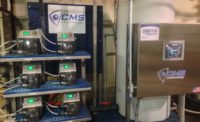When Marty McFly wanted to return to 1985, he pressed a button. When NASA wanted to land on Mars, they pressed a button. And when refrigerated and frozen food processors want to optimize their refrigeration system, yup, you guessed it, they press a button.
Similar to McFly’s ordeal where he has to punch in specific coordinates, and like NASA where they can control the coordinates from afar, these remote operations allow producers to manage the plant without having to actually be in the plant.
For example, Powerit Solutions introduced Spara EMS, an energy management system that enables refrigerated and frozen food processors to automate their energy use for savings and sustainability, says Doug Anderson, vice president of sales and marketing for the Seattle-based company. “Spara users can reduce their electrical bills in two ways—by using the system’s automated demand control features, they can avoid spikes in peak electricity demand that raise customer costs, and by participating in their power supplier’s demand response programs, they can earn payments for relieving stress on the grid,” Anderson adds. “Typically, using Spara also results in managing electricity use to achieve maximum efficiency and improve overall grid stability.”
In addition to cost and energy savings, there are many other advanced technologies that allow operators to optimize their refrigeration systems while ensuring that food quality isn’t compromised, says John Wallace, director of product management for Emerson Retail Solutions, Kennesaw, Ga.
“Some of these features include utilizing learning algorithms and variable frequency drives (or compressor digital technology) to adjust the compressor and fan motors to precisely match load conditions using modulating valves to precisely meter the refrigerant required for the evaporators, sensing the state of the evaporators to determine when a defrost should be terminated,” Wallace says.
The control system also provides the ability to remotely monitor operating conditions, which allows technicians to observe the status of a site from a central office, he adds.
“The ability to see the site status and any indications of alarms remotely means that a technician can diagnose system problems without being on site,” Wallace notes. “In the event that a technician does need to visit the site to fix the problem, he can ensure the proper replacement parts are available, eliminating multiple trips to the site to fix a problem.”
Today’s controls must also offer energy-efficient functionalities.
For example, Hench Control delivers an energy management system that’s truly plug-and-play with proven installations to draw from, all of which are compatible with Hench’s proprietary hardware, according to Matt Chang, vice president of sales and marketing for the Hercules, Calif., company.
“Because the energy management system is not simple ladder logic, it does much more than standard automation,” he adds. “In addition to the peak demand management and compressor control that other refrigeration control systems may be able to do, the Hench energy management system also balances, optimizes and maximizes energy savings in every area possible based on complex algorithms and thermodynamics.”
However, despite today’s fancy control systems, “the biggest thing to keep in mind from an energy point of view is not having a management tool in place to know and understand what is going on with the operation at a granular level,” Chang says. “Having real-time information is good, however if there is no action associated with it, then there is no benefit. Managers need current information, recommendations for improvement and a system that can make changes on the fly with a third-party support team to act as a resource and offer peace of mind.”
If today’s operators were to plunge forward into the future, what would they find?
“There are a number of trends in the energy market that are going to require more sophisticated energy management systems at food processing and manufacturing operations,” Anderson notes. “Technology that enables a tight integration with the smart grid and gives manufacturers the ability to make energy usage decisions based on the state of the grid and the price of energy will reduce the cost of processing, enable facilities to be more competitive and demonstrate a commitment to sustainability.”
5 Control Apps to Consider Today
Refrigerated food manufacturers planning to invest in automation to increase their plants’ energy efficiency should consider five key applications, according to Steve Hawkins, head of automation for Stellar, Jacksonville, Fla.
“Many of these have a payback period of less than a year,” Hawkins says. “While there’s an upfront capital investment, we often see tens of thousands of dollars in savings off of electric bills within months.”
Hawkins recommends manufacturers consider the following:
1. Condenser controls with variable frequency drives (VFDs) and wet-bulb control logic.
2. VFDs on screw compressors.
3. VFDs on evaporator fans.
4. Coordination of the compressor system loads to allow the correct suction set point.
5. Controls that coordinate all equipment, ensuring that one piece of equipment isn’t working against another.
Manufacturers should also measure their refrigeration system’s energy usage, Hawkins recommends.
“While many manufacturers focus on water, air, gas, electric and steam usage of the entire plant, they need to get more granular and look at the different equipment and areas of the plant,” he adds. “By installing additional metering to the refrigeration system, they’ll be better able to make automation and other capital-investment decisions.”





